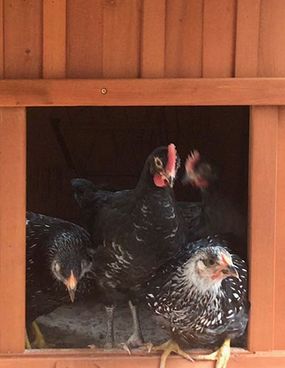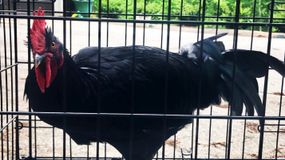You may find yourself asking, “Is a rooster a chicken? How can they mate if they’re different?” when you go to the chicken coop or the barnyard when you’re not used to being there.
In agriculture, particularly poultry rearing, the term “rooster” is used to describe a sexually mature chicken, usually kept by chicken breeders. So yes, a rooster is a chicken.
A Perdue University article also says that a chick is a new chicken hatchling and a pullet is a young female chicken. A young male chicken is called a cockerel, and castrated males are called capons. An egg laying female is a hen.
Raising chickens can be an incredibly rewarding experience. But because there are so many words for different stages of a chicken’s life, it can be hard for new chicken owners to keep track of them. This article will clearly explain what a young male chicken is called and give you a full guide to chicken language.
Key Terms for Male Chickens
Here are the key terms used for male chickens:
-
Rooster – A male chicken over 1 year old. Also called a cock.
-
Cockerel – A male chicken under 1 year old.
-
Capon – A neutered male chicken.
-
Chick – A baby chicken under 12 weeks old of either sex
The term chicken refers to the species overall and can be used for males, females, young and old.
Key Terms for Female Chickens
For comparison. here are the key terms for female chickens
-
Hen – A mature female chicken that lays eggs, over 1 year old.
-
Pullet – A female chicken under 1 year old that has not started laying eggs.
-
Chick – A baby chicken under 12 weeks old of either sex.
Other Chicken Terminology
Here are some other common chicken terms good to know
-
Broiler – A chicken bred specifically for meat production.
-
Layer – A chicken bred specifically for egg laying.
-
Fryer – A young chicken of 3-4 lbs, for frying.
-
Roaster – A larger chicken over 4 lbs, good for roasting.
-
Broody – A hen sitting on and incubating eggs to hatch them.
-
Clutch – A broody hen’s set of eggs she is incubating.
-
Chicks – Can refer to multiple baby chickens.
-
Flock – A group of chickens living together.
Identifying Cockerels
So how can you identify a cockerel? Here are some tips:
-
Feather sexing – Look at wing feathers around 6 weeks old. Pointed = male, rounded = female.
-
Comb/wattle growth – Males tend to develop larger combs and wattles at a younger age.
-
Boldness – Cockerels tend to act more bold, adventurous and aggressive than pullets.
-
Crowing – Cockerels may start crowing around 2-5 months old.
While these signs can help identify cockerels, the only foolproof way is to wait and see if they actually develop into a rooster by 1 year old. Pay attention as your chicks grow to determine when you have young cockerels!

Identifying an Adult Female vs. an Adult Male Chicken
When chicks mature, chicken breeders use a few visual signifiers to distinguish roosters from an adult hen.
The rooster combs and wattles are the most obvious differences between them. These are flaps of skin that show high testosterone levels and may also mean that the rooster is ready to fight off any male rivals. Most breeds of roosters feature a bright red comb for maximum visibility.
Other common indicators are the development of leg muscles and orientation of feathers. Most adult female chicken breeds get thicker legs with short, straight claws when they are ready to lay eggs. Meanwhile the same breed of roosters tend to retain long legs with sharp claws on their feet for defense.
Hen feathers tend to be soft and plush all along the body, while the rooster grows coarser, more exaggerated feathers. Hackle feathers on hens stay short and round their whole lives, but on most male chickens, they get long and fancy ones along the back ridge.
Then there are the long saddle feathers, which populate the tail area and either point rearward or fan out to make the rooster appear larger to foes.
Can Female Chickens Change Sex?
Miss Lucille was a sweet little pullet (young hen), who found a cozy home in the chicken coop of Kristi Allens (not her real name) Powder Springs, Georgia, backyard. Initially, things appeared to be status quo with the young exchequer leghorn cross.
After observing her for a time, however, Allen noticed Miss Lucille was growing a comb. Although both sexes of the breed can have them, Allens instincts told her that perhaps something wasnt quite standard, so she sought the help of a local farmer. Allen recalls:
Advertisement “The farmer did all of the checks to confirm Miss Lucille was a miss. She had no long saddle feathers [pointy feathers at the base of the tail], no aggression, didnt jump or react in the presence of all the hens and roosters, and when she was laid back in the farmers hand, she stuck her legs out straight and just laid there. All are old timers tricks to identifying adult roosters since theres no definitive way to tell until they mount another chicken or crow, aside from lab testing.”
Miss Lucille had “failed” the rooster test. However, later on, Allen arrived home to a mess of feathers in the backyard, an unusual event because female chickens dont usually molt until around 18 months. She also started exhibiting more aggressive behavior.
“She began acting more temperamental, but I attributed that to her molting, as it can be quite uncomfortable for chickens,” she says. “I was worried about her health.”
Although strange things were certainly afoot in Miss Lucilles world, none of them were health-threatening. When her feathers grew back, they were pointed saddle feathers, signaling a transition to an adult male chicken. Her hackles and tail feathers had also undergone some major changes.
“She went from being your typical hen to a rooster with beautiful, long tail feathers and pointy hackles. Her gait changed, and she was definitely at the top of the pecking order,” Allen says.
Further consultation advised a wait-and-see approach. One farmer told her, “Just because she now looked like a rooster didnt mean she was one. I needed to wait until she crowed or mounted one of the hens.”
Ironically, Miss Lucille became more mellow and friendly. “But then her comb kept getting bigger and redder. For every indicator she might still be a she, there was another for her being a he,” she says.
Finally, the irrefutable proof came at around 5 months of age: The rooster literally crowed. “Every day the crow grew louder and stronger. It was official that Miss Lucille was now Mr. Lucille,” Allen says.
“And to his credit, he assumed the role wonderfully. If the girls were low on water, hed crow and let me know to get on it. Hed lead the charge up to roost at night. Hed wake us up with his song early each morning.”
Male, female, and young of the chicken called in English
FAQ
What is a young male chicken called?
The most recognized term for a young male chicken is “cockerel,” referring to those under one year old. “Rooster” becomes applicable when the bird reaches maturity. In some regions, people might use “chick” more generally for any chicken but specifying “cockerel” ensures clarity when talking about young males.
Is a young chicken a rooster?
A young male chicken is commonly referred to as a cockerel. Usually, such hens are aged between six and eight weeks or even one year. You can also call it a young rooster. When aged one year and above, this same male chicken is called a cock or an old rooster. How to Tell if a Chicken is a Rooster?.
What is a young rooster called?
So, even though all chickens roost, the name for a male chicken was changed from roost cock to rooster. Nevertheless, a young rooster is still called a cockerel. Most of the time, “young” means less than a year old. However, the word “cockerel” can also mean a male chicken that was born this year.
What is a baby chicken called?
Chick – The common name for a baby chicken. Peep – Another term commonly used for very young chicks. Pullet – A female chicken that is less than a year old and typically not laying eggs yet. Point-of-Lay – A point-of-lay is a chicken that is about to start laying. This is will typically mean they are around 17 to 20 weeks of age.
What are the different terms for chicken?
There are so many different terms for chickens–juvenile, cockerel, pullet, chick, hen, rooster, peep, biddy, started pullet, point-of-lay pullet, broody, brood, flock—what do they all mean? There ARE a lot of different terms for chicken, aren’t there? It can be a little confusing, especially when you’re just starting out.
What is an adolescent female chicken called?
An adolescent female chicken is called a pullet. A pullet shares many of the same characteristics as an adult hen, and potentially even an adolescent male. She will not yet be laying eggs. Depending on the breed, a pullet can start to lay eggs anywhere from 18 to 22 weeks old.
What is a juvenile male chicken called?
Pullet is the term for a female teenage chicken, while a male teenage chicken is called a cockerel. Between 5-7 weeks, you should be able to begin visually distinguishing males from females. Compared to pullets, the combs and wattles of cockerels often develop earlier and are usually larger.
What do you call an immature male chicken?
Cockerel is a male chicken less than one year old.
What is the proper name for a male chicken?
Chicken Development TermsTermDefinitionCockMale that is a year or olderHenFemale that is a year or olderRoosterA male chicken (includes cock and cockerel)BantamRefers to small breeds of chicken (AKA Miniature Chicken).
What are the 5 stages of a chicken?
The life cycle of a chicken comprises 5 stages- Egg fertilization, Egg embryo, Chick, Pullet, and Adult. A chicken’s life cycle lasts around 21 days, beginning with the hen laying a fertilized egg and ending with the chick hatching.


